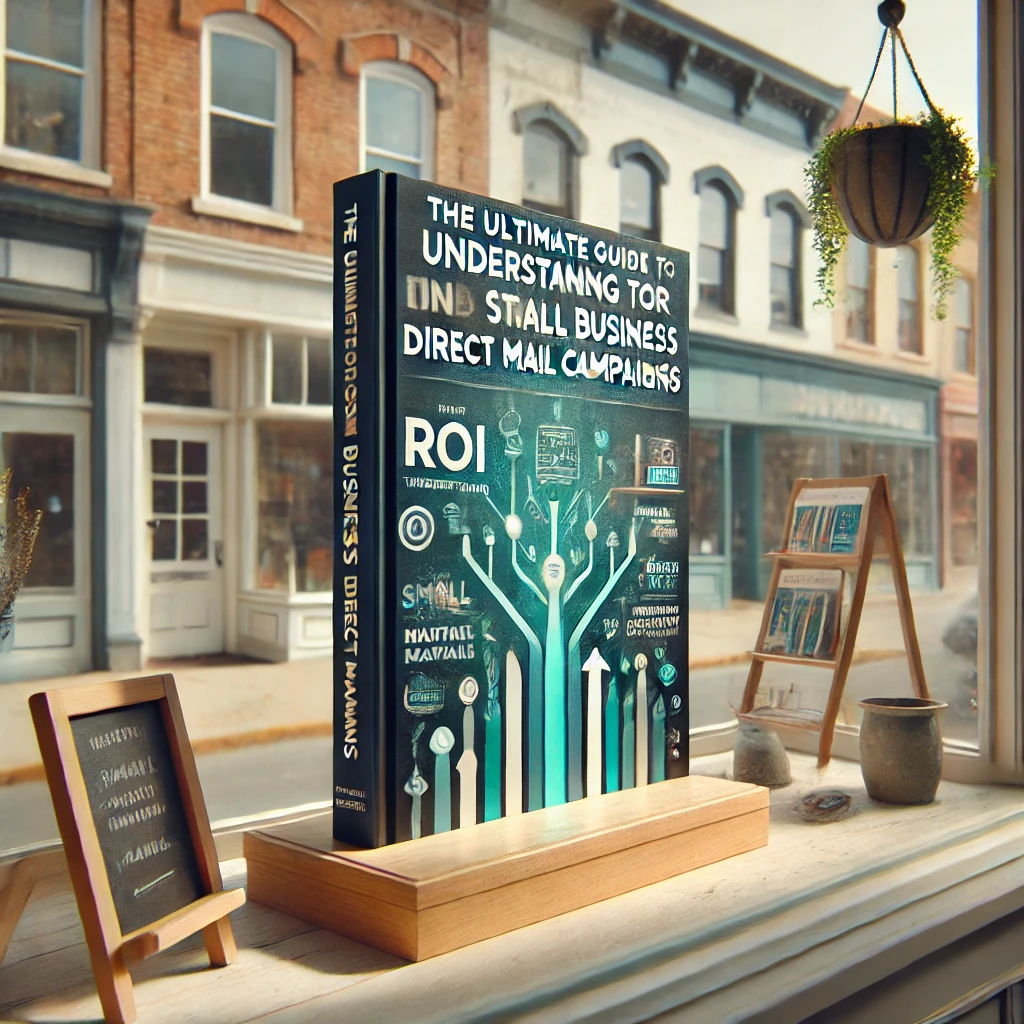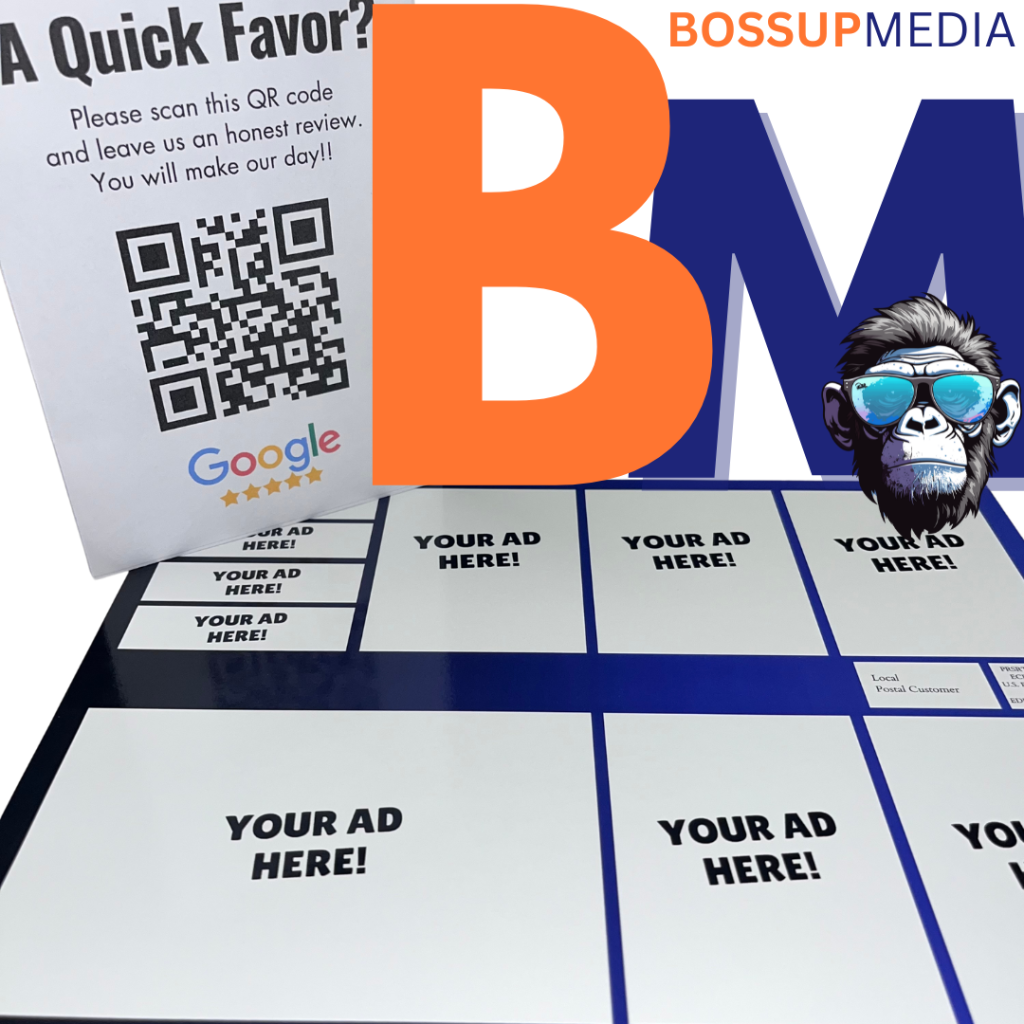The Ultimate Guide to Understanding ROI for Small Business Direct Mail Campaigns
Table of Contents
- Introduction to ROI in Direct Mail
- Why ROI Matters More Than Response Rates
- Common Misconceptions About Direct Mail Metrics
- The ROI Formula Simplified
- Breaking Down ROI: Return vs. Investment
- Why Percent Response Is Misleading
- Example: ROI vs. Response Rate in Action
- Calculating ROI for High-End Industries
- Example 1: Real Estate Campaigns
- Example 2: Luxury Car Sales
- Insights and Optimization Tips for High-End Industries
- Calculating ROI for Low-End Industries
- Example 1: Lawn Care Services
- Example 2: Restaurants and Cafés
- Realistic Expectations and Strategies for Low-End Campaigns
- Understanding Customer Lifetime Value (CLV)
- What Is CLV and Why It Matters
- Example: Comparing One-Time Customers vs. Repeat Clients
- How CLV Impacts Your Direct Mail ROI
- The Role of Conversion Rates in ROI
- From Inquiry to Customer: What Happens in Between
- Example: Conversion Rates for Car Detailing Businesses
- How to Increase Conversion Rates in Your Campaign
- Advanced ROI Optimization Strategies
- Upselling and Cross-Selling in Direct Mail
- Example: Adding Maintenance Plans for Lawn Care
- Shared Mailers: Lowering Costs While Maximizing Reach
- Avoiding Common Pitfalls in ROI Calculations
- Misjudging Customer Value
- Overlooking Campaign Costs
- Relying on Industry-Wide Averages
- The Marathon Runner Analogy
- Why Comparing Industry Stats to Your Campaign Can Be Misleading
- Example: Average Response Rates vs. New Mailers’ Results
- Training Your Campaigns for “Marathon-Level” Performance
- Conclusion: Why ROI Is Your North Star
- Key Takeaways for Successful Direct Mail Campaigns
- How to Use This Guide to Educate and Sell to Clients
Chapter 1: Introduction to ROI in Direct Mail
Why ROI Matters More Than Response Rates
When it comes to direct mail marketing, focusing on response rates can lead to unrealistic expectations. Instead, ROI provides a clear picture of the campaign’s success by factoring in both the cost and the revenue generated. For example, a 1% response rate might be a disappointing thought for most, but for a luxury car dealership, but if each customer brings in $10,000, the ROI could still be phenomenal.
Direct mail campaigns have a unique advantage over digital advertising in that they create a tangible connection with the audience. However, many businesses are misguided by industry-wide “average response rates,” which can vary significantly depending on the type of business, target audience, and campaign design. To truly understand the value of direct mail, you must look beyond percentages and evaluate how much revenue each customer brings in compared to the campaign’s cost.
This chapter will dive into why response rates often fail to tell the full story, how ROI provides a clearer metric for success, and the common pitfalls businesses face when they misinterpret direct mail statistics. By the end of this chapter, you will understand why ROI is the gold standard for measuring campaign performance and how it aligns with your business goals.
Common Misconceptions About Direct Mail Metrics
One common misconception is that response rates directly correlate to success. Businesses often hear that a “good” response rate for direct mail is 1-3%, but this figure is meaningless without context. If a luxury real estate agent receives only a 0.1% response rate on a 10,000-piece mailer with an all-in cost of $0.50 per mailer, but generates $30,000 in commissions from one sale, that campaign is highly profitable. Real estate however is typically one sale and done.
Now if a restaurant sends out 10,000 postcards and receives a 2% response rate, that equals 200 customers. However, if the average ticket size is only $20, the revenue generated ($4,000) which falls far short to cover the $0.50 per mailer campaign costs. But what about lifetime value? Typical restaurant goers, if happy with the service may visit that same establishment multiple times per year. Let’s guess 25% of those 200 new customers return (50 customers) on average 4 times per year for the next 5 years. That’s 20 more total visits x 50 customers, that’s 1,000 visits x $20 a meal! That would total $20,000, 4x the original campaign marketing spend. Not to mention, the friends and family I’m sure they told about their experience. What felt like a loss in the beginning didn’t turn out that bad, and we could always hope for more.
If I gave you a box and told you that for every dollar you put in, four dollars comes back out. Would you keep putting dollars in that box or think it’s a waste of time? Another misconception is that ROI only applies to long-term campaigns. While it’s true that repeated mailings can build brand recognition and improve results, a single campaign can still yield measurable ROI. The key is to set realistic expectations, calculate potential revenue accurately, and understand how customer lifetime value impacts your bottom line.
Chapter 2: The ROI Formula Simplified
Breaking Down ROI: Return vs. Investment
Understanding ROI starts with breaking it down into its simplest components: return and investment. “Return” refers to the revenue generated by your campaign, while “investment” encompasses all associated costs, including design, printing, mailing, and any associated services.
Formula:
This formula provides a percentage that shows how much profit you earned for every dollar spent. For example, if you spent $1,000 on a campaign and generated $5,000 in revenue:
This means you earned 4x the money you invested, making your campaign a success.
Why Percent Response Is Misleading
Percent response rates often fail to account for the value of each customer. For example, consider two campaigns:
- A lawn care service spends $500 and receives a 3% response rate (60 inquiries). If the average sale is $50, the revenue is $3,000, resulting in a high ROI.
- A luxury car dealer spends $5,000 and receives a 0.1% response rate (10 inquiries). If one sale generates $10,000 in profit, the ROI is still substantial.
In both cases, focusing on ROI rather than response rates paints a clearer picture of success.
Example: ROI vs. Response Rate in Action
Let’s say a business mails 10,000 postcards at a total cost of $2,000. The business receives 100 responses, yielding a 1% response rate. From these responses, 10 new customers make a purchase, with an average sale value of $500.
Step 1: Calculate Total Revenue
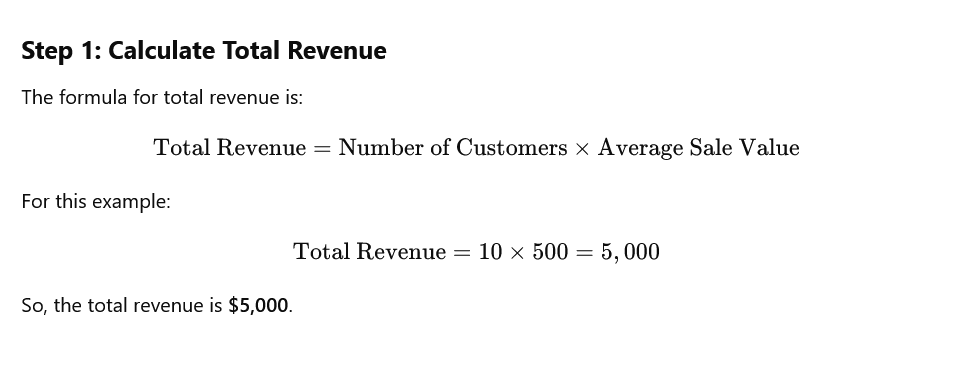
Step 2: Calculate ROI
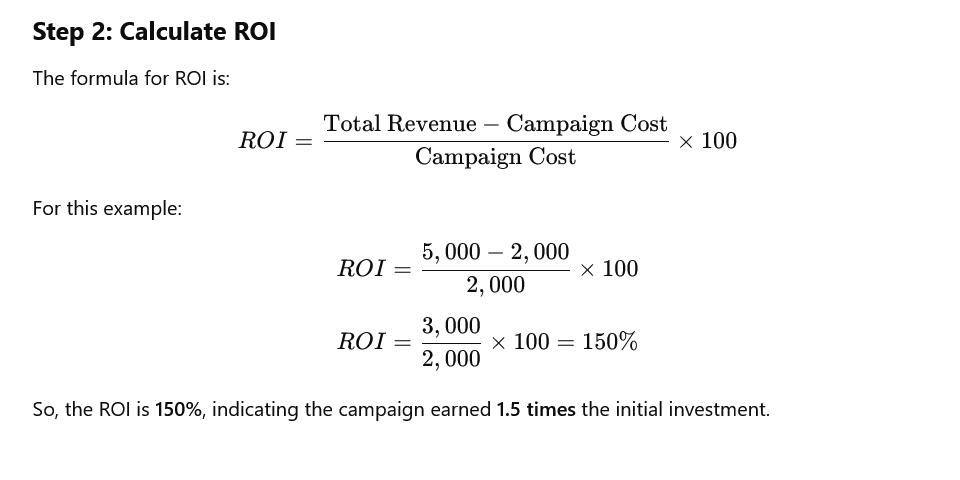
Analysis
This means the business earned 1.5 times its initial investment, delivering a 150% ROI. Despite the seemingly modest 1% response rate, the campaign was highly successful because the revenue per customer was high relative to the campaign cost.
Why ROI Is More Informative
Focusing solely on response rates (in this case, 1%) might make the campaign seem less effective. However, ROI provides a clearer picture of profitability by factoring in the revenue generated from those responses. In this example, each new customer brought in significant revenue, making the campaign worthwhile.
Testing and Scaling
Once the ROI of a small campaign is validated, businesses can scale their efforts. For example:
- Increase the mailing volume to 20,000 postcards.
- Optimize the postcard design to improve conversion rates.
- Experiment with offers to increase the average sale value.
By testing and iterating, the business can continue to refine its strategy and achieve even higher ROI in future campaigns.
Chapter 3: Calculating ROI for High-End Industries
Example 1: Real Estate Campaigns
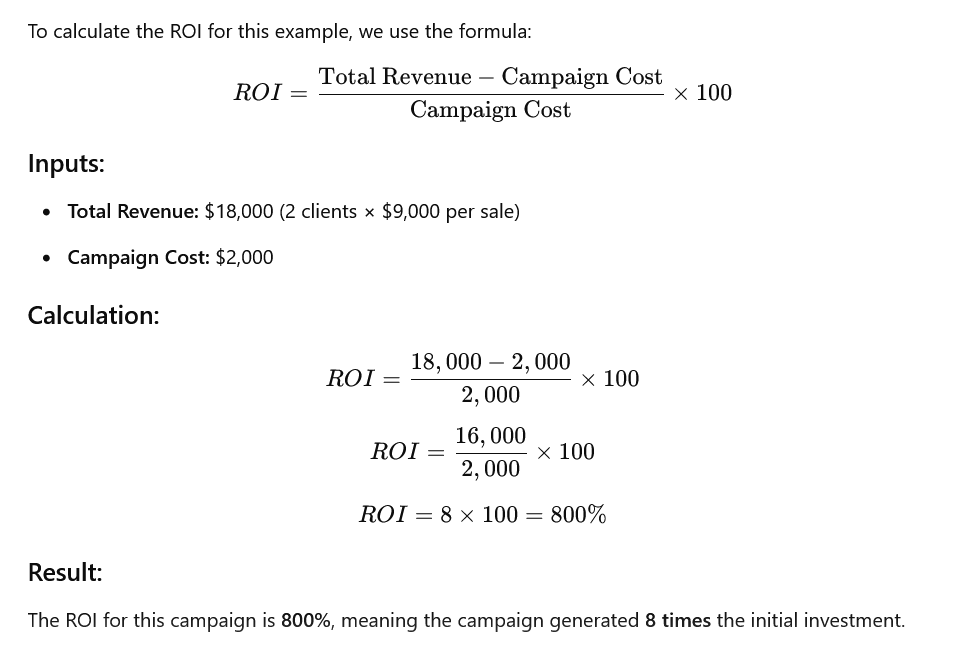
This example illustrates how even a small number of responses can lead to significant ROI in high-end industries. By targeting the right audience and crafting a compelling offer, real estate agents can achieve exceptional results.
Example 2: Luxury Car Sales
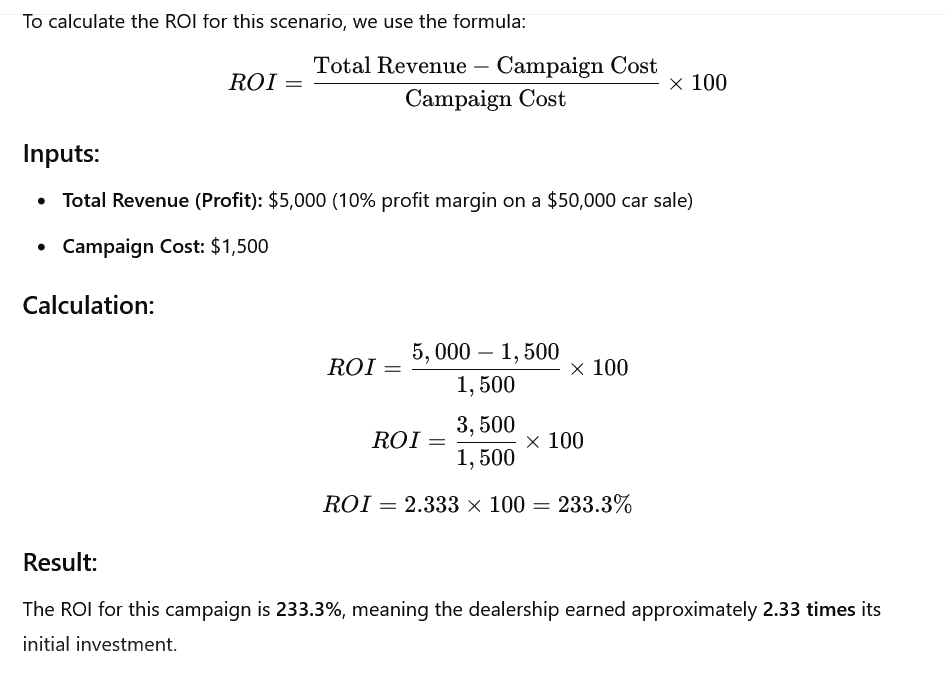
This example highlights the importance of understanding customer value in high-end industries. A single sale can offset the entire campaign cost and deliver substantial profits.
Insights and Optimization Tips for High-End Industries
To maximize ROI in high-end campaigns:
- Target Precision: Focus on affluent neighborhoods or individuals likely to purchase high-ticket items.
- Compelling Offers: Include exclusive incentives, such as limited-time discounts or VIP experiences.
- Follow-Up Strategy: Combine direct mail with personalized follow-up calls or emails to nurture leads.
Chapter 4: Calculating ROI for Low-End Industries
Example 1: Lawn Care Services
For low-end industries such as lawn care services, understanding ROI can help businesses allocate their budgets effectively and set achievable goals. Let’s explore a real-world example.
- Scenario: A lawn care business spends $500 to mail 2,000 postcards to local households.
- Average Transaction Value: $50 per lawn mowing service.
- Lifetime Value (LTV): $500 (10 services per year per customer).
- Results: If the campaign generates five new customers, the revenue from a single transaction per customer is $250 ($50 x 5 customers). However, the LTV of these customers over a year is $2,500 ($500 x 5 customers).
ROI Calculation
To calculate ROI, consider the total campaign cost ($500) and the LTV revenue ($2,500):
This campaign delivers a 400% ROI, showcasing the potential profitability of direct mail for small service-based businesses.
Key Takeaways
- Focus on LTV, not just the initial transaction value.
- Offer incentives to encourage long-term commitments, such as discounted seasonal packages.
- Track customer retention and upsell opportunities to maximize ROI.
Example 2: Restaurants and Cafés
Restaurants and cafés are another low-end industry where direct mail can yield impressive results. Let’s break down an example:
- Scenario: A local restaurant invests $1,000 in a direct mail campaign, distributing 5,000 postcards.
- Offer: A “Buy One Entrée, Get One Free” coupon.
- Average Ticket Size: $30 per table.
- Redemption Rate: 2% (100 customers).
- Results: Each table redeems the coupon, resulting in a revenue of $3,000 ($30 x 100 tables).
ROI Calculation
The ROI for this campaign is calculated as follows:
Strategies for Success
- Use time-limited offers to create urgency.
- Track coupon redemptions to measure campaign performance.
- Upsell customers with drinks, appetizers, or desserts to increase average ticket size.
Realistic Expectations and Strategies for Low-End Campaigns
Low-end industries often operate on tighter margins, making ROI optimization critical. Here are some strategies to maximize your results:
- Target Your Audience Precisely: Use demographic data to target households likely to need your services.
- Leverage Shared Mailers: Reduce costs by participating in co-op mailers that feature multiple businesses.
- Combine Offers: Pair direct mail with email campaigns for a cohesive marketing strategy.
- Track Results: Use unique codes or QR links to monitor redemptions and measure ROI effectively.
Chapter 5: Understanding Customer Lifetime Value (CLV)
What Is CLV and Why It Matters
Customer Lifetime Value (CLV) represents the total revenue a business can expect from a single customer throughout their relationship. CLV is a critical metric for understanding the long-term profitability of your direct mail campaigns.
Formula:
For example, if a restaurant’s average transaction value is $30, customers visit four times a year, and the average retention time is three years, the CLV is:
This means each customer is worth $360 over their lifetime.
Example: Comparing One-Time Customers vs. Repeat Clients
Consider two scenarios for a car detailing business:
- One-Time Customer: The business spends $50 to acquire a customer who pays $300 for a single detailing service. The ROI is:
- Repeat Client: The same customer signs up for a maintenance plan, paying $300 annually for three years. The LTV is $900, and the ROI becomes:
How CLV Impacts Your Direct Mail ROI
Understanding CLV allows businesses to:
- Set Realistic Budgets: Spend more to acquire high-value customers.
- Design Better Offers: Focus on long-term benefits rather than short-term gains.
- Optimize Campaigns: Track retention rates and upselling opportunities to improve ROI.
Actionable Tips
- Calculate your CLV regularly to reflect changes in customer behavior.
- Offer loyalty programs to increase retention.
- Use direct mail to promote subscription plans or repeat services.
Chapter 6: The Role of Conversion Rates in ROI
From Inquiry to Customer: What Happens in Between
Conversion rates measure the percentage of inquiries that turn into paying customers. A high conversion rate is crucial for maximizing ROI.
Formula:
For example, if a lawn care service receives 50 inquiries and converts 10 into customers, the conversion rate is:
Example: Conversion Rates for Car Detailing Businesses
- Scenario: A car detailing business sends out 1,000 postcards and receives 50 inquiries.
- Conversion Rate: 20% (10 customers).
- Revenue: Each customer spends $300, resulting in $3,000 in revenue.
- ROI: 200%
How to Increase Conversion Rates in Your Campaign
- Improve Your Call-to-Action: Use clear, compelling language that motivates recipients to act.
- Personalize Your Offers: Tailor messages to specific demographics or customer segments.
- Follow Up: Combine direct mail with email or phone follow-ups to nurture leads.
- Test Your Campaigns: Experiment with different designs, headlines, and offers to identify what works best.
Final Thoughts
Conversion rates are a key component of ROI, bridging the gap between inquiries and revenue. By tracking and optimizing your conversion rates, you can significantly enhance the profitability of your direct mail campaigns.
Chapter 7: Advanced ROI Optimization Strategies
Upselling and Cross-Selling in Direct MailUpselling and cross-selling can significantly increase the average sale value, improving overall ROI. Let’s consider an example from the lawn care industry:
- Scenario: A lawn care business offers a basic mowing service for $50 but uses direct mail to promote premium packages, such as fertilization and pest control, for an additional $200 per season.Result: Out of 100 customers, 20 opt for the premium package, increasing the average sale from $50 to $90.
ROI ImpactThe additional revenue from upselling premium services can transform campaign outcomes:
- Campaign Cost: $500
- Revenue from Basic Services: $5,000 (100 customers x $50)
- Additional Revenue from Premium Packages: $4,000 (20 customers x $200)
- Total Revenue: $9,000
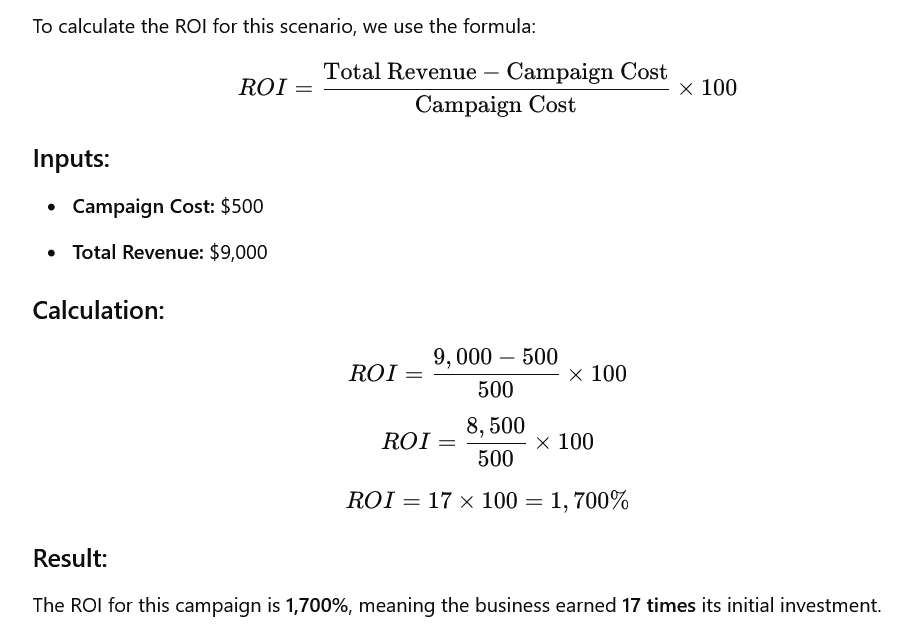
Actionable Tips
- Bundle Services: Create irresistible packages that combine basic and premium offerings.Personalize Offers: Use customer data to target households likely to opt for higher-value services.Highlight Value: Emphasize the long-term benefits of premium services in your mailers.
Shared Mailers: Lowering Costs While Maximizing Reach

Shared mailers allow businesses to split printing and postage costs with other local companies. This strategy is particularly effective for small businesses with limited budgets.
- Example: A co-op mailer features ads from a restaurant, a salon, and a fitness center, reaching 20,000 households for $1,000 per business.Result: Each business benefits from greater exposure while keeping costs low.
ROI ImpactConsider the fitness center’s results:
- Campaign Cost: $1,000New Members: 50Average Membership Value: $300Total Revenue: $15,000ROI:
Advantages of Shared Mailers
- Cost Efficiency: Reduce individual costs by sharing expenses.Wide Reach: Access larger audiences than individual mailers.Community Building: Strengthen local business networks by collaborating with non-competing partners.
Long-Term ROI Strategies
Direct mail campaigns should be part of a broader, long-term strategy. Repeat mailings can reinforce brand recognition and improve response rates over time. Consider:
- Seasonal Campaigns: Align mailings with peak business seasons.Follow-Up Mailers: Send additional mailers to non-responders with revised offers.Loyalty Programs: Use direct mail to reward repeat customers and encourage referrals.
Chapter 8: Avoiding Common Pitfalls in ROI Calculations
Misjudging Customer Value is one of the most common mistakes in direct mail campaigns is underestimating customer value. Businesses often focus solely on initial transactions, overlooking the potential for repeat business.
- Example: A car detailing business spends $1,000 on a campaign, acquiring 10 new customers at $300 each. If the business ignores lifetime value and assumes $3,000 in revenue, they’re missing out on the additional $600 each customer might spend annually on maintenance packages.
Solution: Calculate both initial and lifetime revenue to get a comprehensive understanding of ROI. Use historical data to estimate repeat business and upsell opportunities.
Overlooking campaign costs is another pitfall is failing to account for all campaign costs, including design, printing, postage, and tracking software. Hidden expenses can erode ROI and make campaigns appear less effective than they are.
- Example: A restaurant invests $1,000 in mailers but spends an additional $300 on graphic design. Ignoring this cost results in an inflated ROI calculation.
Solution: Itemize all campaign expenses before calculating ROI.
Use spreadsheets or specialized software to ensure accuracy. Relying on Industry-Wide averages while benchmarks can provide a starting point, relying solely on industry-wide averages can lead to unrealistic expectations. Direct mail performance varies significantly based on factors such as audience, offer, and timing.
- Example: A luxury real estate agent expecting a 3% response rate based on generic stats might be disappointed when their niche audience yields a 0.5% response rate. However, the higher value of each sale can still deliver excellent ROI.
Solution: Set expectations based on your specific business, audience, and campaign history.
Test small batches to establish your own benchmarks before scaling up.
Chapter 9: The Marathon Runner Analogy
Why Comparing Industry Stats to Your Campaign Can Be Misleading. Just as marathon runners train for years to achieve competitive times, successful direct mail campaigns require time and refinement. Comparing your campaign to industry averages is like comparing a casual jogger to a professional athlete—the context is entirely different.
Example: Average Response Rates vs. New Mailers’ Results
Industry stats often report average response rates of 1-3%, but these figures typically come from experienced mailers with optimized strategies. A first-time campaign might yield a lower response rate, but this doesn’t mean it’s unsuccessful. Training your campaigns for “Marathon-Level” performance, Improving direct mail ROI is a process of iteration and optimization:
- Start Small: Test a limited batch of mailers to gather initial data.Analyze Results: Evaluate response rates, conversion rates, and ROI to identify strengths and weaknesses.Refine Strategies: Adjust targeting, messaging, and offers based on insights.Scale Up: Gradually increase your mailer volume as your campaign becomes more efficient.
Chapter 10: Conclusion: Why ROI Is Your North Star
Key Takeaways for Successful Direct Mail Campaigns
- Focus on ROI, Not Just Response Rates: A low response rate can still deliver a high ROI if customer value is significant.
- Understand Your Metrics: Track conversion rates, CLV, and profit margins to make data-driven decisions.
- Iterate and Improve: Use small campaigns to test and refine strategies before scaling up.
How to Use This Guide to Educate and Sell to Clients
- For Marketers: Use the examples and spreadsheet to demonstrate the value of direct mail.
- For Businesses: Contact Me Apply the strategies and tools to optimize your campaigns and maximize ROI.
By focusing on ROI and leveraging the strategies outlined in this guide, you can transform your direct mail campaigns into powerful, revenue-generating tools.

